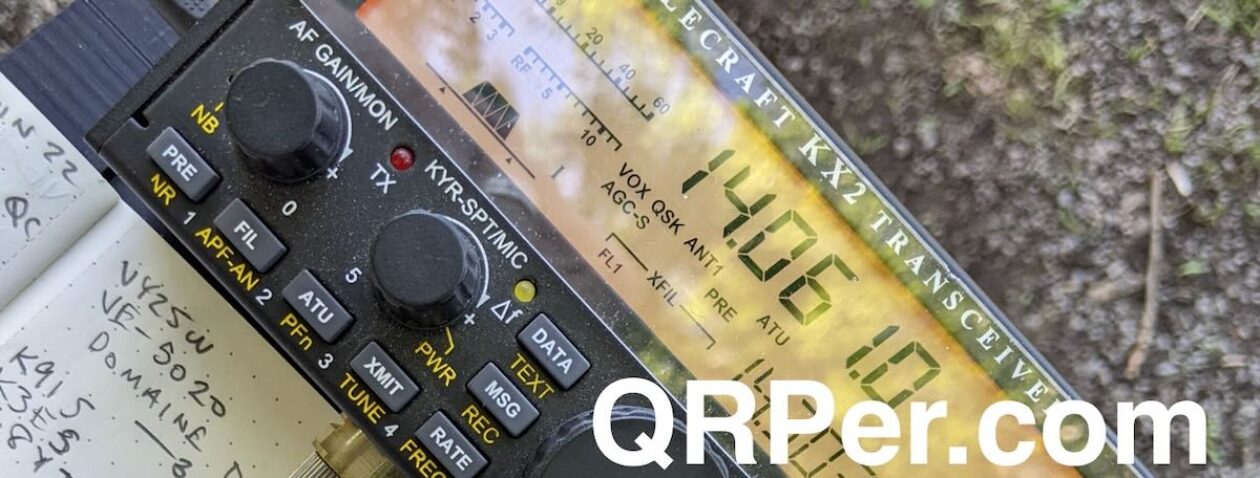
Guest Post: The Full Moon, Eels, and /P Operation on Mount Peyton, NL, Canada
by Scott (VO1DR)
Introduction
I have been eyeing Mount Peyton in central Newfoundland for years as an attractive spot for /P HF operation. Even before my radio adventure to Mount Sylvester (reported earlier in QRPer.com), I have been seeking a way to get up Mount Peyton. Like Mount Sylvester, Mount Peyton is an inselberg of granite protruding above the glacial plain of central Newfoundland. However, Mount Peyton is even larger and higher; an elongated ridge about 800 m long reaching up to 487 m (1,599 ft) above sea level. For SOTA enthusiasts, it is designated VO1-CE-005, multiplier 4.
Figures 1 and 2 show the location local topography around Mount Peyton.


Mount Peyton is a case of “so near and yet so far”. Just west of Gander, this ridge is visible in the distance south of the Trans-Canada Highway (the main arterial highway traversing the island of Newfoundland). However, in summer there is no trail directly to the top, and access to its base is only via rough ATV tracks and wet bogs. One must get to the base of the mountain, then hike overland to the south side and climb a long inclined cleft in the hillside to the top. This cleft is the surface trace of a fault in the underlying granite (see route on Figure 2). By contrast in winter, Mount Peyton is a popular and readily accessible snowmobile destination with dozens of machines roaring up this same cleft on a thick blanket of snow.
The Full Moon and Eels
Looking at maps and Google Earth, an approach on foot would entail a three-day hiking trip. While this sounds delightful, my current living situation would not permit this, and in addition I have no hiking buddies able and willing to make such a commitment. So, it became clear I needed all-terrain vehicles (ATVs) to get quickly to the base, so we could do the entire trip in one long day.
I don’t own an ATV and after multiple attempts over this summer to find any ATVers interested in such an adventure, there were no takers. Apparently ATVers like to ride, but don’t like to get off their machines ?. I finally found a local outfitter (Paul) who not only could supply ATVs, but had hiked multiple times to the top of Mount Peyton – a perfect fit. For safety, I needed at least one extra person to go to the top. All other potential radio or hiking companions fell by the wayside for various reasons, so it became just me and Paul.
As is common in rural Newfoundland, Paul is a Jack of all trades and is also a commercial eel fisherman. American Eels (Anguilla rostrata) have a fascinating life history (https://en.wikipedia.org/wiki/American_eel) and inhabit freshwater rivers and streams in Newfoundland. Paul harvests them in conical net traps anchored to the stream bottom (Figure 3).

He told me that eels run during the new moon and stay put near the full moon. Now doesn’t that ring deep bass notes of evolutionary biology!? Since eel fishing is an important part of Paul’s income, we agreed to fit in my radio around his eel-catching. He would be available around the full moon when the eels were sluggish; toward the end of September, the moon was full on the 29th. Given the local weather, we settled on Tuesday, September 26 as our day. Isn’t life fascinating – the moon controls eel movement, which controls human movement, which controls our /P radio expedition!
Getting There was Half the Fun
I drove from St. John’s to Paul’s cabin west of Glenwood, NL on the afternoon of Sep 25, on the beautiful shores of Indian Arm Pond (Figures 4 and 5).


We planned an early departure on the ATVs. Sun-up was around 7 am and sun-down was about 7 pm, so we had 12 hrs of daylight to work with. September 26 dawned bright and clear (Figure 6) and we were soon packed and underway on two ATVs (Figure 7). We drove for over 2 hrs on a wide range of roads, tracks, and rough trails to a point where we dropped the ATVs and started hiking (one way distance 26.7 km or 16.6 mi).





This trip reinforced that I am not a motor sports guy. The ATV ride was long, bone-jarring, and noisy. Buying an ATV at great expense and doing this for “fun” is a mystery to me; and forget about seeing any wildlife. But, hey, the ATVs got us there; we couldn’t have done this trip without them! Continue reading Guest Post: The Full Moon, Eels, and /P Operation on Mount Peyton, NL, Canada





























